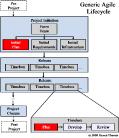Mike Lowery – a fantastic Scrum coach – has written a post called It might look like rapids, but it’s still a waterfall. This is part of Mike’s series on Scrum coaching patterns (or team anti-patterns) and in this post he concentrates on the “The Cataract of Stealth”.
Mike starts by outlining how a sprint should look: “you should see a sort of tag team effect where 1 or 2 stories are in flight, as they get close to being finished the next stories are kicked off”. In contrast “The Cataract of Stealth” means the team start too many user stories at the same time thus risking finishing any of the user stories at the end of the sprint. Often this is caused by team imbalance, e.g.. too many developers for the number of testers.
The cataract of stealth is a real problem and I recommend people have a look at Mike’s post for more detail including his very sensible solutions. (It also has shades of the Overcommitment Bear Trap.)
I just want to add one thing. What Mike’s post highlighted for me was a (small) convergence of Scrum and Lean/Kanban thinking. The constraint on having “1 or 2 stories” in flight during a sprint is work in progress (WIP) constraint – a concept straight from Lean/Kanban.
